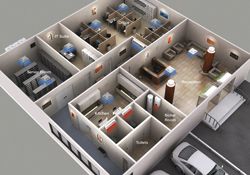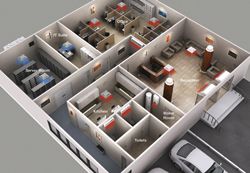It is now possible for buildings to achieve previously unheard of air conditioning efficiencies running into double figures. John Durbin, Daikin UK's engineering department manager, looks at how, by using whole-building-thinking design, outstanding efficiency levels can be achieved.
Although it can be argued zero heat rejection design is still more of an aspiration than an operational reality, a combination of design and technological advances is moving buildings nearer to this goal. COPs now pale in comparison with the efficiency levels that can now be achieved. At Daikin we can achieve COPs of 10.07*.
To achieve outstanding figures such as this an intelligent approach to the whole building's needs must be taken, rather than looking at different areas in isolation. The first step is to incorporate heat recovery. The technology of reclaiming heat from one area in the building and transferring it to another has come a long way since its introduction in the wake of the energy crisis of the 1970s. Then, it was not considered a serious part of a building's climate control systems.

Typical summer heating/cooling

Typical winter heating/cooling
But if we are to make serious efficiency gains, we need to incorporate heat recovery as part of a fully-integrated climate control system. Every day, hundreds of tonnes of CO
2 are released as waste heat. If we capture this and reuse it we will achieve the highest levels of efficiency.
By taking unwanted heat generated from IT suites or telecoms equipment and reusing it elsewhere, energy will cost less and carbon emissions will be drastically reduced. However, excess heat can only be used if required. The aim must be to reject heat only after every avenue has been explored.
The reclamation of heat can be achieved by certain heat pumps that divert heat from indoor units in cooling mode, to areas that require heating. Air source heat pumps, which are cheaper to install than ground source heat pumps, can be used. They can achieve significant energy cost savings, compared with traditional fossil fuel boiler systems, by using solar heated air to produce 65 per cent - 75 per cent renewable heat.
Their effectiveness can be maximised by the use of multiple zones on one circuit. Flexibility means the design of every project can be optimised, so you can cool IT and server rooms, provide hot water for sinks and radiators, use heat reclamation for ventilation and incorporate entrances requiring air curtains.
Variable Refrigerant Volume technology has been key to this system of heat recovery for some time. Its advantage for commercial environments is that it varies the refrigerant volume within the air conditioning system to match the building's requirements at any moment. This allows each area to maintain its set temperature, while saving both money and carbon emissions, because it uses only the minimum level of energy.
Now, by employing heat recovery in balanced mode within a VRV system, it is possible to deliver previously unheard of efficiencies of up to nine or even 10.
So how does it work? Like conventional heat recovery, balanced mode operation involves cooling an area of the building that is experiencing the highest heat gains and transferring that recovered heat to areas which require heating (or hot water). It is important the design process ensures the indoor units are arranged to maximise the occasions when this balanced operation can take place.
However, it is vital to analyse from the start a building's multiple requirements, usage patterns and varying occupancy levels, in order to design a fully integrated system.
Consultants and engineers need to be involved at the earliest stages of the design process to help architects and systems designers make the right decisions and incorporate the latest thinking on heat recovery within the building modelling process.
By doing so, project teams and their clients will discover the significant impact that integrated heat recovery solutions can have on the reduction of energy usage and will be able to reproduce efficiency levels that until recently they could only dream about.